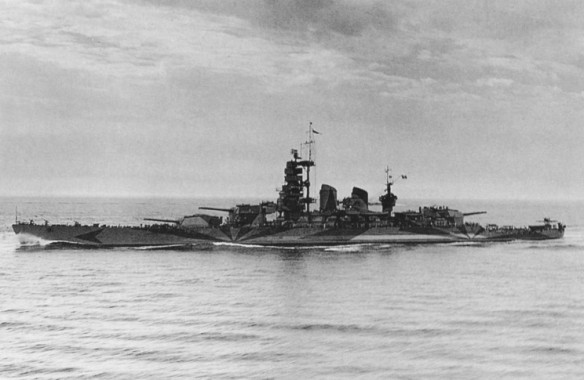The Vittorio Veneto saw more action than any other Italian battleship, being hit twice by torpedoes and once by bombs.
The first modern Italian battleships, the three Vittorio Venetos, were also the last. They displaced some 40,000 tons, were armed with nine 15-inch main battery guns, and their indigenous Belluzo geared turbines gave them the impressive speed of 30 knots, faster than the contemporary King George Vs, and only exceeded by the U. S. Iowas. Vittorio Veneto and Littorio/Italia were completed in 1940, and in November of that year Littorio was badly damaged by British aerial torpedoes at Taranto. It was repaired and renamed Italia after the fall of Italian dictator Benito Mussolini. Vittorio Veneto survived a number of unsuccessful actions against the Royal Navy in the Mediterranean. The last unit of the class to enter service, and the last Italian battleship, Roma, completed in June 1942, was not so fortunate. Roma was blown up with heavy loss of life by a German television-controlled glider bomb in September 1943 as it was proceeding to surrender to the Allies. Work on the fourth ship of the class, Impero, was suspended, but the hull was taken over by the Germans as war booty in 1943 and used as a target and test subject; it then sank during a U. S. air raid, was later salvaged and towed to Venice, and there beached and broken up by 1950, a never-completed battleship.
With her sister Littorio, the Vittorio Veneto formed the spearhead of the Italian navy at the outbreak of World War II, having been completed in April and May 1940 respectively. Both formed the 9th Division at Taranto, where it was hoped they would deter the British Mediterranean Fleet by virtue of their high speed and heavy armament.
Both ships put to sea several times in response to British operations, but they missed the Battle of Calabria on 9 July 1940, The Vittorio Veneto was lucky not to be damaged during the Fleet air raid on Taranto in November 1940.
The new Italian battleship Vittorio Veneto came close to seeing action, along with Giulio Cesare, on 27 November 1940, when an Italian force consisting of the two battleships, six cruisers, and six destroyers, commanded by Admiral Ingio Campioni, attempted to attack a British convoy escorted by the RN battleship Ramillies, the battle cruiser Renown, the aircraft carrier Ark Royal, as well as light cruisers, destroyers, and support vessels, under the command of Admiral Sir James Somerville. The forward cruiser forces on both sides exchanged fire at a range of 12 miles. But when the Italians learned of the presence of an RN aircraft carrier, they turned about for homeport Naples. This clash took place only about two weeks after the devastating RN carrier raid on the Italian fleet at Taranto, and the Italians were apparently still demoralized.
On 28 March 1941 while taking part in a sweep against the British convoys evacuating troops from Greece to Alexandria and Crete, the Vittorio Veneto was hit by a torpedo dropped by one of HMS Formidable’s Fairey Albacores, The 457-mm (18-in) torpedo hit abaft T turret on the port side at 15.21. Serious flooding followed and power was lost on the port outer propeller shaft, but she could still steam, and limped away to the North West.
More British attacks followed at dusk, missing the battleship but hitting one of her escorting cruisers, the Pola. The engineers and damage control parties worked hard to stem the flooding, and by 20.34 the Vittorio Veneto’s speed had increased to 19 kts, and she was able to make her way back to Taranto for repairs, leaving the Pola and two sisters to be destroyed by the British Mediterranean fleet during the night.
In December 1941 the Vittorio Veneto was hit by a torpedo from the British submarine HMS Urge, and needed another three months in dock. She joined the Littorio for an operation against a British convoy in mid-June 1942, but the Italians were losing the initiative, and thereafter she spent most of her time in La Spezia as Taranto was under constant air attack. On 5 June 1943 she was damaged by Allied bombers, and the following September she joined the melancholy line which steamed to Malta to surrender to the British.
The Vittorio Veneto was interned at Alexandria while the Allies debated the future of all Italian warships. There was talk of ‘tropicalizing’ the three ‘Littorio’ class battleships as fast carrier escorts for the Pacific but they lacked endurance, and although they returned to Italy in 1946 they were not permitted to be incorporated into the post-war Italian Navy, being sold for scrap m 1951.
Construction: Littorio/Italia: Ansaldo (October 1934-May 1940); Roma: CRDA (September 1938-June 1942); Vittorio Veneto: CRDA (October 1934-April 1940); (A fourth unit, Impero, was broken up, uncompleted, in 1948-1950.)
Displacement: 40,724-45,485 tons
Dimensions: 735′ x 780′ x 107’5″ x 31’5″ (averages for class)
Armament: 9 x 15″ 4 x 3-gun turrets
Armor: 13.8″ belt; 3.5″-6.4″ main deck; 7.9″-13.8″ turrets
Machinery: 4 x shaft Belluzo geared turbines = 128,200 hp = 30 knots
Complement: 1830-1950
Fate: Littorio: broken up, 1948-1955. Roma: sunk by German television-guided glider bomb, 9 September 1943. Vittorio Veneto: allocated to Britain as war reparations, scrapped 1948-1951. Littorio/Italia: Littorio renamed Italia after Italy’s surrender in 1943; allotted to the United States as reparations; scrapped 1948-1955.
